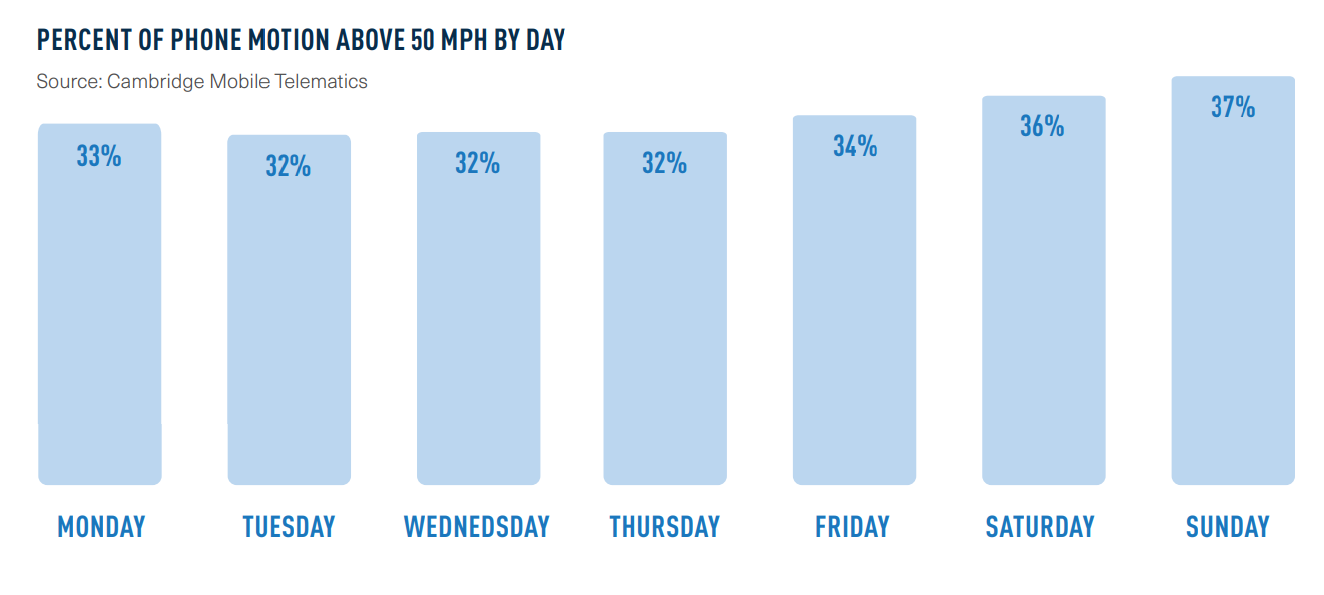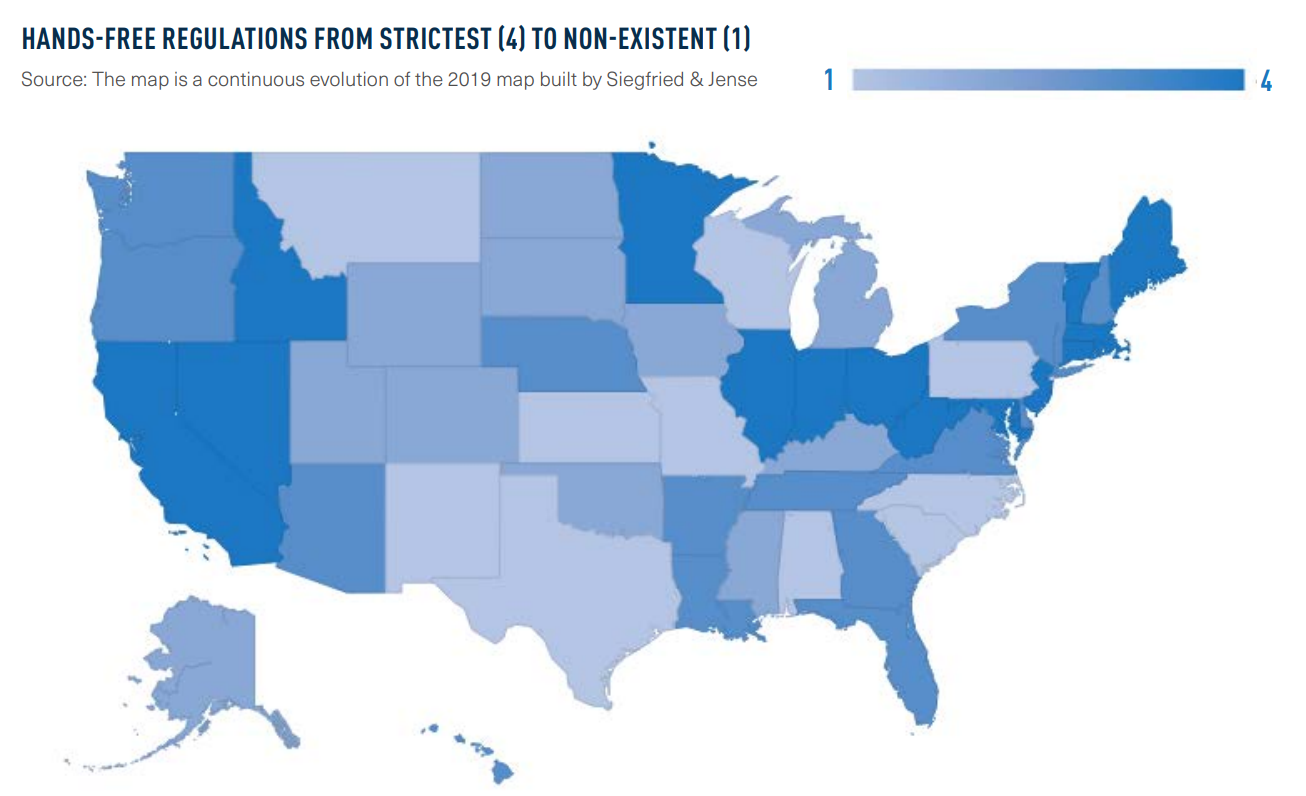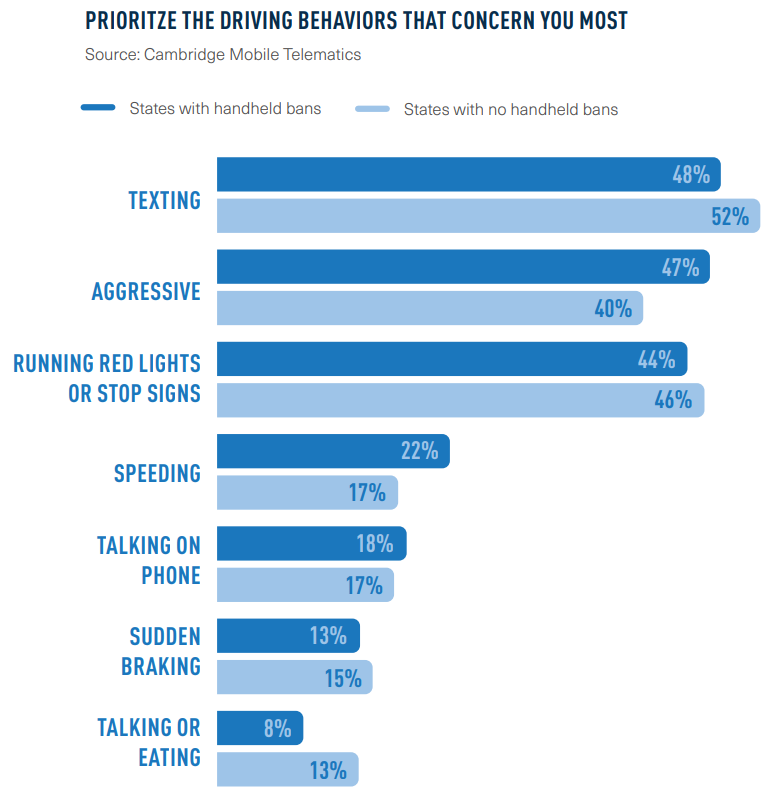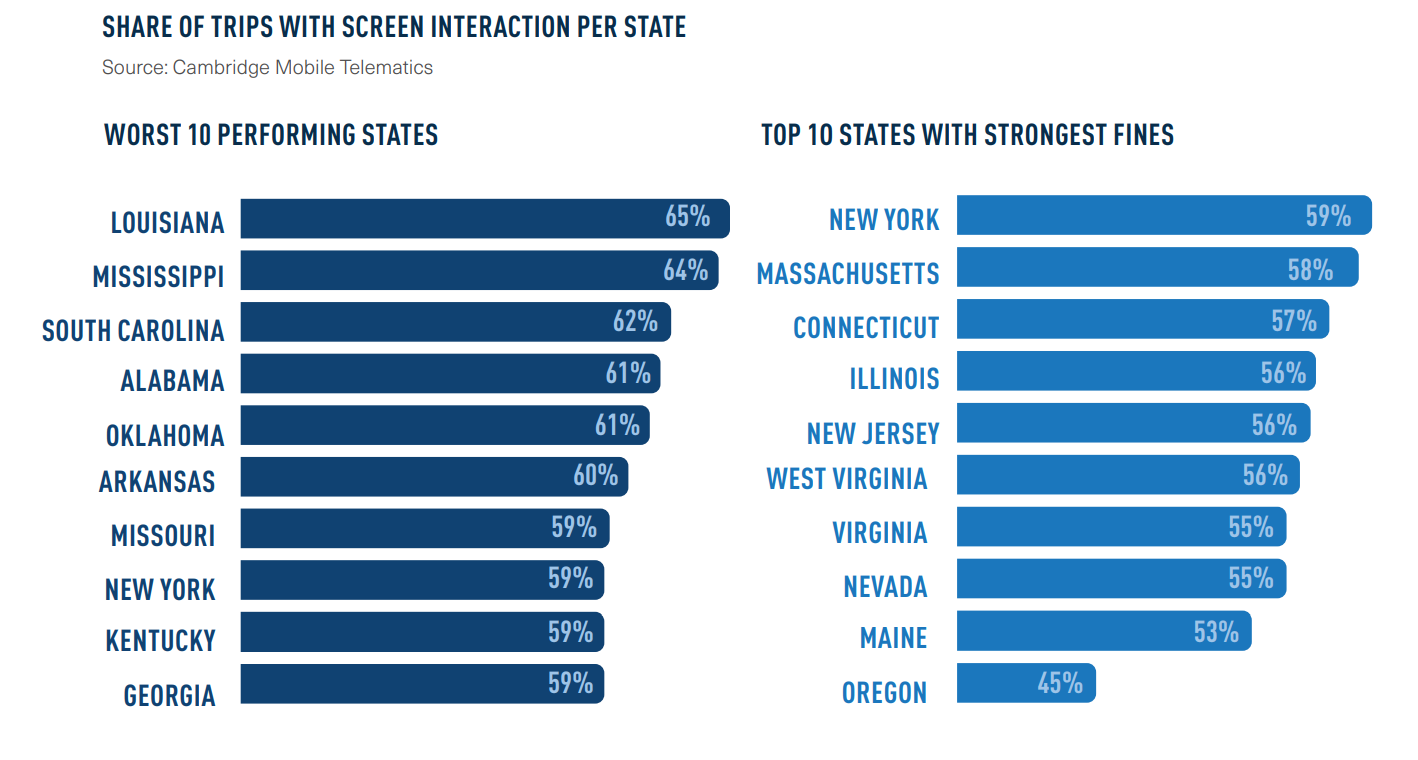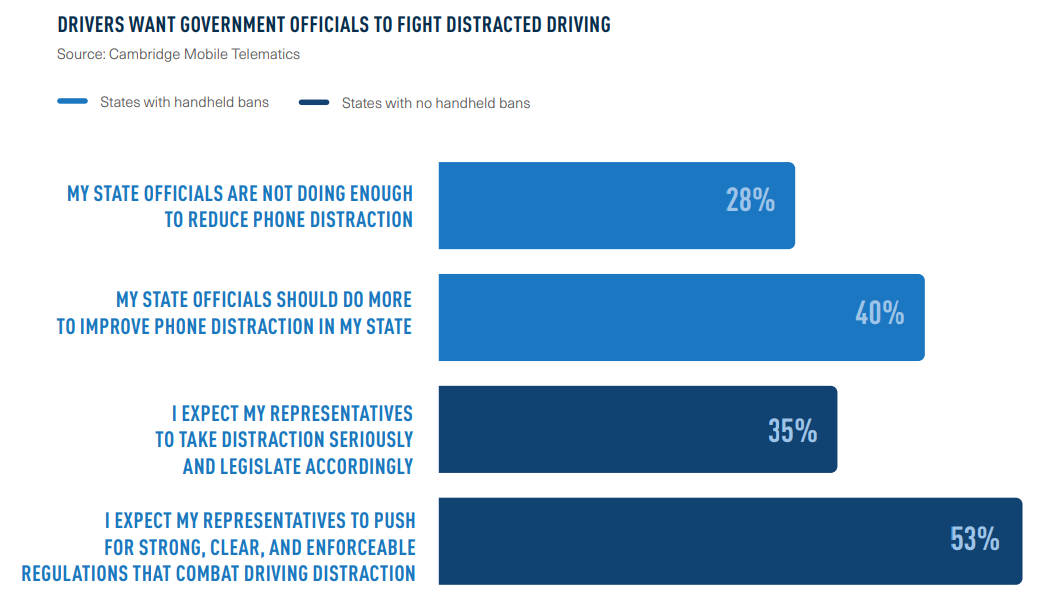
CMT: Drivers using phone on more than half of trips, solutions to mitigate distracted driving
By onEducation
Cambridge Mobile Telematics (CMT)’s “The State of Distracted Driving in 2023 & the Future of Road Safety” report found that drivers interacted with phones on nearly 58% of their trips and Vice President of Insurance and Government Affairs Ryan McMahon says the passage of distracted driving laws helps but isn’t the cure-all.
“In almost every case, new laws reduce risk, and that reduction persists for months but in many cases, there is a regression that occurs,” he said. “Passing laws helps but is not enough to think that it’s the single tool to fix this problem. It’s a major problem that needs new solutions. The truth is that the sheer prevalence of distracted driving in America is staggering.”
Americans spent two minutes and 12 seconds per driving hour interacting with their phones last year, an increase of 23% over 2020, according to the annual report.
“We wanted to help people understand the consequences of these increases,” the report states. “Our research shows that the 23% increase in distracted driving in 2022 caused an estimated 420,000 additional crashes, 1,000 fatalities, and $10 billion in economic damage — compared to 2020.”
CMT found that 34% of phone motion distractions happened last year at speeds of 50 mph — the highest rate in three years.
Distracted driving has also increased around major holidays since 2020 with 62% of trips on Thanksgiving including screen interactions, which was the highest of any day of the year and up 7% from two years before. Christmas had the highest percentage of trips with screen interaction over the past three years, averaging 61.5%.
In eight states that have introduced hands-free legislation since 2018, representing over 34 million drivers, there was, on average, a 13% reduction in phone motion within three months of the law going into effect. If that percentage could be sustained, CMT says more than 38,000 crashes could be prevented saving close to 100 lives and preventing $930 million in crash-related costs.
“CMT’s mission is to make the world’s roads and drivers safer,” McMahon told Repairer Driven News. “The National Highway Traffic Safety Administration estimates that distracted driving killed over 3,500 people in 2021, but emphasizes that the number is likely much higher. …Our goal with the report is to educate policymakers, industry leaders, road safety advocates, media, and others on the prevalence of distracted driving and provide solutions for how we can stop this deadly behavior.”
CMT completes its annual research with its DriveWell telematics platform that uses advanced signal processing and artificial intelligence “to make sense of complex sensor data from connected vehicles, tags, smartphones, and dashcams and extracts insights about distraction and other driving behaviors,” McMahon explained.
Distracted driving indicators that are observed in real-time and anonymized include when a phone is in motion, when there is screen interaction, when the phone is in a mount, when handheld and hands-free calls are made, and contextual information like speed bands, time of day, road types, weather, and more. DriveWell is used by 21 of the top 25 U.S. auto insurers and nine of the top 10 representing more than 80% of U.S. drivers.
“In the report, we focus on the distraction elements that both governments and auto insurers seek to reduce through policy and pricing practices, including handheld phone calls and handheld phone use, which includes phone motion and screen interaction,” McMahon said.
“A major highlight that we have published on is that there are solutions that are working. We highlight a number of studies in the report that show that telematics helps drivers get safer. Drivers who get feedback on their behaviors have reduced distraction by 25%. Drivers who frequently engage with their telematics app are 57% less distracted than unengaged drivers, and they get safer over time. In one study, we found that the most engaged drivers reduced their distraction by 20% in just two months. All of our Safest Driver Programs have shown significant drops in distraction as well.”
CMT’s latest research shows that 3 in 4 Americans in states without a handheld ban see drivers texting while driving every day and nearly 9 in 10 see drivers talking on the phone while driving. On top of that, 7 in 10 said texting and driving is the most dangerous activity that can be done while driving.
“Distracted driving significantly increases the chance of crashing. CMT research has uncovered two key insights on this front. The first is that drivers who crash are 2X more likely to interact with their phone the minute before the crash. In other words, drivers who crash are more likely to be distracted before the crash. The second finding is that of all the drivers who crash, 34% interacted with their phones within the minute before the crash.”
The key to distracted driving mitigation is data analysis, education, and awareness, according to CMT.
“Understanding the nature of the issue will bring more resources,” McMahon said. “So far, I think it’s fair to say that the insurance industry has been one of the major groups combatting distracted driving, even though that’s probably not widely known. Insurers have invested in programs that match rate to risk, and as distracted driving has become a larger risk, they have increased the tools that they have to understand the components of it and provide incentives to ultimately reduce that risk. That can be seen through their deployment of telematics programs, and their investment in lobbying for improved distracted driving laws to improve roadway safety.”
Telematics programs through insurance carrier mobile apps are one new tool widely used, he added, as well as usage-based insurance programs. CMT predicts adoption of telematics programs will accelerate significantly over the next year to 18 months.
“We’re also seeing other industries offer safe driving programs powered by telematics,” McMahon said. “The gig delivery and rideshare companies are helping drivers learn about their driving habits with telematics. State and local governments are adopting telematics safe driving programs as another way to increase awareness among citizens.”
Currently, 80% of consumers who have heard of telematics have a favorable view of it. However, most drivers aren’t aware of distracted driving, or the lack thereof, in their home state.
“CMT research found that most drivers do not know what the law is in their state. In states with a handheld ban, just 32% of drivers said they knew about it. About 40% didn’t know about the regulation or didn’t understand what it meant. In states without a handheld ban, drivers were even less clear about the laws. Only 8% of drivers correctly said their state doesn’t have a ban. Fifty-three percent thought there was a ban, and 58% didn’t understand the details of the laws.”
CMT also aims to educate policymakers, industry leaders, and road safety advocates. “Drivers may agree that they want government officials to do more, but they don’t have a unified solution,” CMT’s report says. “In states without handheld bans, 43% of drivers said they want stronger regulations that prohibit phone use and distraction. Just 5% are happy with the status quo.
“In states without handheld regulation, an overwhelming majority of voters want their state governments to take action. This sentiment is especially strong in large states like Texas, Pennsylvania, and Florida, where over 94% of respondents want legislators to introduce distraction regulations. Legislation for handheld bans faces a number of hurdles to be successful, including the severity of the fines, education and awareness programs, and enforcement.”
One of those hurdles is the societal view of distracted driving, which mitigating the act of depends on how it’s talked about, CMT wrote. CMT notes the argument that distracted driving doesn’t have a social stigma like drunk driving “making it a challenge to gain support and funding for it.”
“The words we use to describe distracted driving are constantly evolving, complicating the efforts to define and legislate it,” the report states. For instance, drivers don’t just ‘text today. They send direct messages, or ‘DMs.’ They don’t just make phone calls. They FaceTime, Zoom, and WhatsApp. Social media platforms like Instagram and TikTok further exacerbate the problem. These apps use visuals instead of text, so drivers may not consider them distracted driving in the context of ‘don’t text and drive’ legislation or campaigns.”
CMT’s report also highlights how grassroots organizations, including The Kiefer Foundation, Stop Distractions, Oklahoma Challenge, Safe Roads Alliance, and EndDD.org, are changing the culture around distracted driving.
Some of what CMT includes about each organization:
-
- The Kiefer Foundation: Founded by former General Motors executive, Michael Kiefer, following the death of his 18-year-old son by a distracted driver, the foundation’s work includes advocating for hands-free legislation across the country, raising awareness about the dangers of distracted through campaigns and initiatives with schools and community organizations as well as supporting the development and implementation of new technologies aimed at reducing distractions and improving road safety.
- Stop Distractions: Founded by Jennifer Smith after the loss of her mother in a crash caused by a distracted driver, the nonprofit focuses on raising awareness about the issue nationwide “so others don’t have to experience the pain of losing someone to distracted driving.”
- Oklahoma Challenge: Focuses on empowering young drivers to drive safely. The organization partnered with CMT to use its Safest Driver platform to encourage positive behavior change among drivers.
- Safe Roads Alliance: President Emily Stein’s passion for distracted driving education and prevention was prompted by her father’s death caused by a distracted driver. The alliance advocates for stricter laws, increased awareness, and improved road safety. Under Stein’s leadership, the alliance collaborates with policymakers, law enforcement agencies, and the public.
- EndDD.org: Volunteer speakers including nurses, physicians, safety experts, driver’s education instructors, lawyers, and others have provided science-based education programs on how to stop driving distracted and speak up when they see others drive distracted to more than 500,000 teens and adults.
To view CMT’s full report, visit cmtelematics.com/distracted-driving-report-2023.
Images
Featured image credit: PeopleImages/iStock
More information
27% of survey respondents OK with texting while driving, distractions cause nearly 3K deaths a year
Use of smartphone apps while driving prevalent, especially among gig workers, IIHS finds

